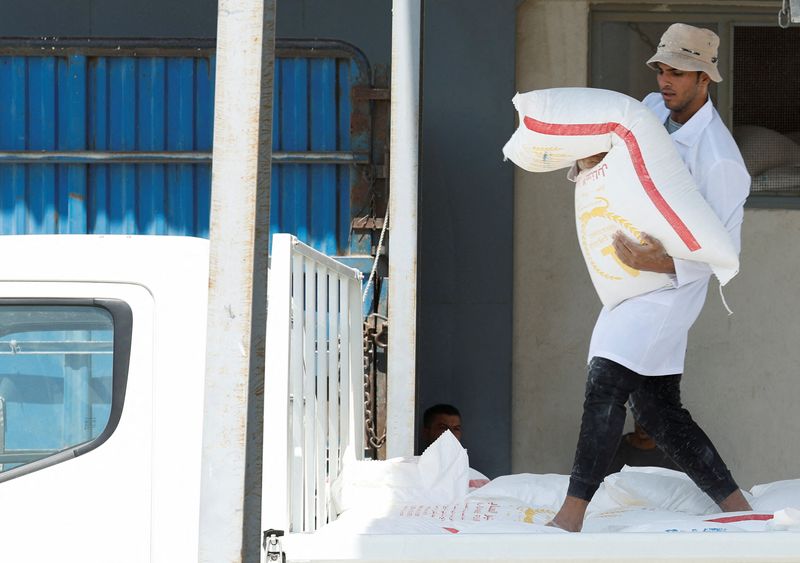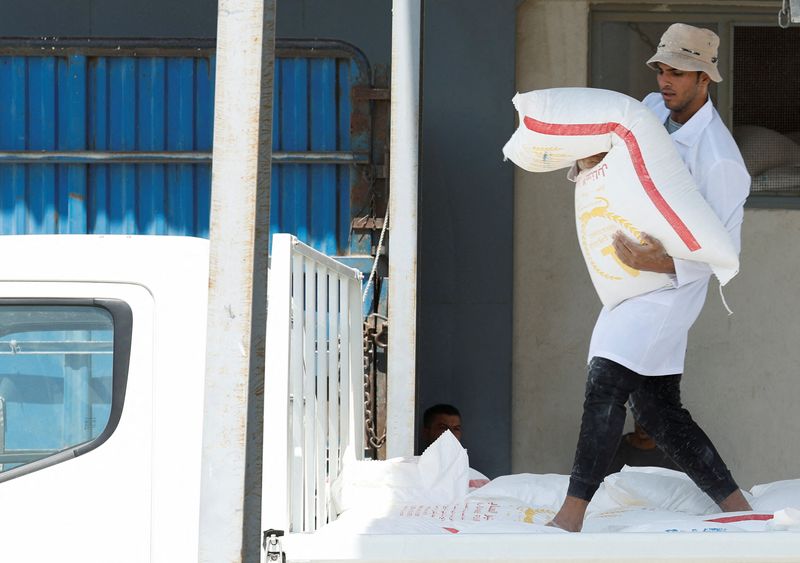Commodities
Exclusive-Iraq set to pay high price for bumper wheat harvest

By Sarah El Safty and Muayad Kenany
DUBAI/NAJAF, Iraq (Reuters) – A bumper harvest and a hefty grain surplus in Iraq, typically one of the Middle East’s biggest wheat importers, has left the government with the prospect of a net loss of nearly half a billion dollars, according to Reuters calculations.
The 1.5 million metric ton wheat surplus, helped by better than expected rains but above all by government subsidies, is excellent news for farmers.
For the government, however, which pays them more than double the global market price to encourage cultivation of the food staple in often arid conditions, the price is high.
According to the calculations, based on official figures and conversations with more than 10 government officials, farmers, mill owners, analysts and exporters, the government will have made a loss of $458.37 million, once it has paid the farmers and assuming it manages to sell the excess to private millers in Iraq at an agreed price.
Critics say it needs to better balance the challenges of motivating farmers and limited financial and other resources.
“This is poor planning,” said Adel Al Mokhtar, former adviser to the Iraqi parliament’s agriculture committee. “Why do we produce more than we need, which also leads to wasting water?” he asked.
To meet the needs of its subsidy programme, the government needs between 4.5 and 5 million tons annually.
Historically, Iraq, as part of the Fertile Crescent from the Mediterranean to the Gulf is where farming developed more than 10,000 years ago.
In recent years, Iraqi agriculture has suffered from a lack of rainfall linked to climate change, less water flowing through its two main rivers, the Tigris and the Euphrates, and decades of conflict that have interfered with cultivation.
The United Nations puts Iraq among the five most vulnerable countries to climate change globally, making food security a priority for the government.
But the country, the second largest producer in the Organization of the Petroleum Exporting Countries (OPEC) is also facing a reduced budget in 2025 after lower oil prices.
“If oil prices start coming down the government has first to pay salaries of public service employees so how much will be left to subsidise the agriculture sector, that’s the question nobody knows the answer to,” Harry Istepanian, an independent energy and water expert in Washington and a senior fellow at the Iraq Energy Institute, said.
STORAGE PROBLEM
Baghdad could try to export its surplus but said it prefers to keep it inside the country and support its millers. Limited storage space means it cannot store the surplus for next year, Haider Nouri, director general of Iraq’s grain board, told Reuters.
Although the government was buying for 850,000 Iraqi dinars ($649.35) and selling for 450,000 dinars, it did not consider that a loss because the grain was staying in the country, Nouri said.
“There is no loss considering that the money is spent inside the country and in Iraqi currency, employing workers, supporting flour (mills), relying on the local product, and abandoning flour imports from Turkey, the Emirates, and Kuwait,” he said.
Farmers said rains had helped them, but the government subsidy was crucial.
Ashour Al Salawi, a farmer in Iraq’s southern province of Najaf, said the government price had led him to increase the area he planted with wheat by 50% to a total of 15 dunums. A dunum is a land measure of less than an acre.
In contrast to previous years, he said the money was paid on time.
“There’s a huge difference between this year and previous years,” Abbas Obeid, another farmer in Najaf, said.
“It was the compensation but we were also provided with water, electricity and subsidised fertilisers.”
Mohsen Abdul Amir Hadhud, head of the agricultural cooperative in Najaf, said most farmers had seen a major improvement in their lives.
“The farmers’ living conditions have improved due to government support for the wheat crop. They have restored their homes, increased the cultivated areas, and purchased good agricultural supplies,” Hadhud said.
The government also provided support for other crops such as rice, buying it at a price between 850,000 and 1 million Iraqi Dinars depending on its quality.
MILLERS BARGAINING POWER?
The decision to keep the surplus wheat in Iraq could lead to pressure on the government from the millers for lower selling prices given that they potentially can import for less.
“The price set by the government, which is 450,000, is not final, and we expect the price to be reviewed by the government, since the price that the government will sell to mills is higher than the global price,” Ali Fadhel, director of Al-Aswar Company, a private sector mill, said.
Farmers, meanwhile, may find themselves less well rewarded in the 2025 season, when Nouri said Baghdad was considering cutting the price it pays them.
“It is possible that the price of purchasing wheat will decrease [next year]…but it will not be significant, and will be higher than the global market,” he said.
The farmers in Najaf, say that undoubtedly will mean less wheat.

“It would be a disaster if they decrease the price next year,” Hussein El Morshedy, whose production increased more than 60% this year, said.
($1 = 1,309.0000 Iraqi dinars)
Commodities
Oil prices rise; U.S. crude inventories plunge, Russia-Ukraine truce eyed
Commodities
India’s Reliance to stop buying Venezuelan oil over US tariffs, sources say
Commodities
Oil prices climb on Venezuela supply worries

 Forex3 years ago
Forex3 years agoForex Today: the dollar is gaining strength amid gloomy sentiment at the start of the Fed’s week

 Forex3 years ago
Forex3 years agoUnbiased review of Pocket Option broker

 Forex3 years ago
Forex3 years agoDollar to pound sterling exchange rate today: Pound plummeted to its lowest since 1985

 Forex3 years ago
Forex3 years agoHow is the Australian dollar doing today?

 Cryptocurrency3 years ago
Cryptocurrency3 years agoWhat happened in the crypto market – current events today

 World3 years ago
World3 years agoWhy are modern video games an art form?

 Commodities3 years ago
Commodities3 years agoCopper continues to fall in price on expectations of lower demand in China

 Economy3 years ago
Economy3 years agoCrude oil tankers double in price due to EU anti-Russian sanctions



























